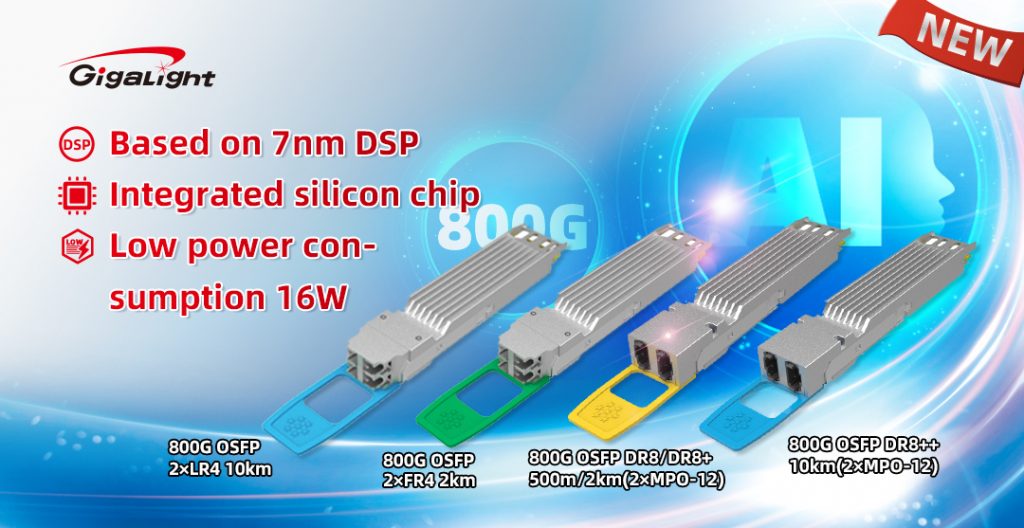It doesn’t matter where you run, what matters is the right direction
Optical communications field – the main application scenarios of silicon photonic chips
With the rapid development of artificial intelligence (AI) and machine learning (ML) applications, the demand is for components to exchange data quickly and consume as little power as possible while maintaining high computing density, especially in terms of short-distance connections between XPUs (CPU, GPU, and memory).
The AI computing era we are facing has the following characteristics:
- Require faster network speeds – rapidly advancing towards 800G/1.6T
- Require network products to have lower latency – improve computing efficiency, and increase the response speed and training speed of AI systems
- Require network products to have lower power consumption – reduce energy consumption and develop sustainable AI computing power
- Require higher reliability of system hardware and software – reduce failure rate, improve availability and user experience of AI services
In this context, traditional pluggable optical modules are already “stretched” in terms of cost performance and power consumption, while highly integrated high-speed silicon photonic chips have become a more superior option due to their obvious advantages in potential price reduction and power consumption. The market’s choice is the best proof. Silicon photonic modules have achieved partial commercial success, and the application of higher-speed silicon photonic modules will also increase significantly.
Silicon photonics is emerging as a promising technology compared to traditional methods. Silicon photonics can enable better communication between computing units such as CPUs and GPUs. Memory units can also be improved to increase the computing power and efficiency of AI applications.
Gigalight Silicon Photonics Transceiver
In response to the comprehensive goal of large-scale commercial use and technological advancement of 800G architecture in AI data centers at home and abroad, Gigalight launched a low-power 800G series silicon photonic modules based on 7nm DSP with a power consumption of 16W, including 800G DR8\DR8+, 800G 2×FR4/2×LR4 data center optical modules, supporting OSFP and QSFP-DD packaging forms, laying a solid delivery foundation for the company to become a pioneer in the field of silicon photonics.

800G OSFP 2×FR4/ 2×LR4
Gigalight’s 800G OSFP 2×FR4 and 800G OSFP 2×LR4 optical module ports use 2× Dual LC interfaces. The transmitter uses a monolithic integrated silicon photonic modulation chip solution, using 4 CWDM4 light sources. The integrated silicon photonic chip realizes 1-to-2 light source and CWDM wavelength division and MZ modulation. The receiver is 2 discrete free-space optical POSAs and adopts a low-power direct-drive 7nm DSP chip solution. The product has the advantages of low power consumption and high performance.

800G DR8/DR8+/DR8++
Gigalight’s 800G OSFP DR8/DR8+/DR8++ optical module port uses a 2×MPO-12/APC interface. The transmitter uses a monolithic integrated silicon photonic modulation chip solution, uses two CWL light sources, and implements 1-to-4 and MZ modulation of the light source in the integrated silicon photonic chip. The receiver uses two discrete FA solutions and a low-power direct-drive 7nm DSP chip solution. This product has the advantages of low power consumption and high performance.

At the same time, Gigalight also provides 800G silicon photonic modules in QSFP-DD package to meet the needs of different users.
800G QSFP-DD DR8/DR8+/DR8++
- 1310nm CW+MZ+PIN
- 500m/2km/10km
- <14.5W/16W

800G QSFP-DD 2×FR4/ 2×LR4
- CWDM4 CW+MZ+PIN
- 2km/10km
- <16W

400G DR4
As early as 2023, Gigalight has mass-produced 400G OSFP-RHS DR4 and 400G QSFP112 DR4 silicon photonic modules. The addition of the latest low-power version 800G silicon photonic series has strongly promoted the company’s confidence in the growth of next-generation optical communication performance. Gigalight has substantially entered the research and development of silicon photonic chips and silicon photonic modules since 2018, and has completed the mass production or sample stage of at least 10 silicon photonic modules. Thanks to the strong collaboration of the global supply chain, more innovative and differentiated silicon photonic modules will be launched in Gigalight in the future.

In the 800G AI computing center, the 800G silicon photonic module can branch two 400G optical modules through single-mode optical fiber to achieve a smooth upgrade of the 400G network.


